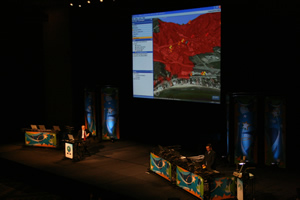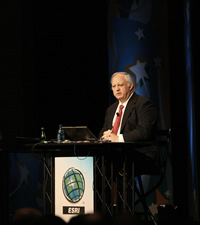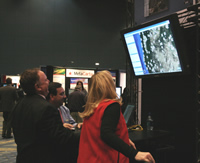Esri Previews ArcGIS 9.3 at the FedUC
By Emily Vines, Esri Writer
 During the FedUC, Esri demonstrated the GIS technology used to create sophisticated maps showing the encroachment of a wildfire into a neighborhood. Esri produced the maps during the devastating series of wildfires Southern California experienced in October 2007. |
ArcGIS 9.3 software will provide new mashup capabilities, sophisticated modeling tools, improved image processing and delivery, and many other enhancements, Esri president Jack Dangermond told more than 2,000 people meeting at the Esri Federal User Conference (FedUC) in Washington, D.C., last month.
Dangermond and his staff detailed the improvements users can expect with the 9.3 version of ArcGIS software, scheduled for release in the third quarter of 2008. Quality will greatly improve, and many small enhancements have been made to give users the tools they have requested. Those details will have a positive impact on their daily routines. Throughout the plenary, Esri staff and users demonstrated the latest technology and innovative applications in ArcGIS 9.3, starting with ArcGIS Desktop. Improvements in cartography at 9.3 will include support for curved graticules, what you see is what you get (WYSIWYG) editing, and better street numbering placement and contouring labeling.
In modeling, there will be more refined iterative modeling, improved contouring, introduction of scatterplot graphics, and geographically weighted regression. For 3D visualization, users will find better support of KML and Microsoft environments and for time series animation as well as improved rendering to support Collaborative Design Activity (COLLADA) texturing for buildings. ArcGIS Desktop 9.3 usability enhancements include easier access to bookmarks, a new Pause Labels option and Convert Graphics to Features function, a new option to simulate layer transparency in all legends, advanced sorting options, and the ability to more easily change symbology.
Moving on to ArcGIS Server, Dangermond described the addition of new REST and Javascript API's for delivering fast and user-friendly mashup GIS Web applications. The ArcGIS API for JavaScript is a browser based API for developing high performance, easy to use mapping applications. The ArcGIS JavaScript Extension for Google Maps and the ArcGIS JavaScript Extension for Microsoft Virtual Earth allow you to extend the Google Maps API and the Microsoft Virtual Earth API (respectively) to use ArcGIS Server services. The JavaScript APIs are powered by backend REST services that can be hosted on any Java or .Net installation of ArcGIS Server. "This means that you can build standalone web mapping applications and mashup content with any ArcGIS Online service, with Google Maps, and with Microsoft Virtual Earth," said Dangermond.
 James Cason, who spoke at the FedUC, serves as the U.S. Department of the Interior's senior agency official for geospatial information (SAOGI). |
Dangermond explained enhancements to image processing and delivery. ArcGIS Server is and has been a very strong foundation for managing imagery. But now, the latency from image acquisition to accessibility has been greatly reduced. Dangermond referred to the new image services in ArcGIS Server that are similar to map or globe services, but are dedicated to serving imagery. These new image services can be accessed by desktop applications - such as ArcGIS Desktop or image processing applications - as well as browser-based applications. In addition, ArcGIS Image Server will be fully integrated into ArcGIS Server at 9.3, allowing users to make very large image datasets quickly accessible in a large range of applications throughout their entire enterprise. Also new in the next release of ArcGIS Server will be role-based security, and more support for varied interoperability standards, including Web Coverage Service (WCS), Transactional Web Feature Service (WFS-T), and KML 2.1.
Additionally, ArcGIS Server will support PostgreSQL, PostGIS, and DB2, which will allow users to store many types of geographic data in virtually any open source or commercial database or on a file system.
A new mobile GIS application will be integrated with ArcGIS Server. Users will be able to download it to a portable device, such as a cell phone, and perform editing, querying, and routing. This application can also task a server to do more sophisticated analysis.
Replication an Important Concept
Shifting to a discussion of the geodatabase, Dangermond asserted to the plenary audience that one of the key concepts to understand about the geodatabase is replication. "This is important for realizing the vision of the National Spatial Data Infrastructure [NSDI]," he said. "This suggests that we can have multiple servers at different locations with copies of the same data, like a central database for the whole country, a regional database, or a database for a state or city, where each is being updated independently with replication services that update each other at a certain set time, be that a specific day, week, or hour.
"Suddenly," he said, "I can have the same data in multiple locations being updated in a distributed environment with replication services. That entire infrastructure has been built into ArcGIS Server."
Harnessing the Power of Geospatial Technology
Keynote addresses by secretary of the U.S. Department of the Interior (DOI) Dirk Kempthorne and associate deputy secretary of the DOI James Cason focused on the advances in and benefits of geospatial technology. Kempthorne has designated Cason as the department's senior agency official for geospatial information (SAOGI). Cason is also the chair of the Federal Geographic Data Committee (FGDC) Steering Committee and will be the secretary's lead on the newly formed National Geospatial Advisory Committee.
 At the FedUC, Esri's Bernie Szukalski demonstrated the capabilities of ArcGIS Explorer for integrating a wide variety of Web-based and local content. |
Kempthorne spoke to the plenary audience via video. He referenced John Wesley Powell's exploration and mapping of the Colorado River and his later role as one of the first directors of the U.S. Geological Survey (USGS). "He launched our nation on a journey to discover our land and it continues today, 139 years later, at this conference," Kempthorne said.
Kempthorne talked about the remarkable technological advances in geospatial technology. Those advances allow people to see the world in a new way and provide the tools for addressing sustainability and managing disasters. "The possibilities, indeed the promises, of this technological revolution are literally beyond imagining for both this generation and future generations," he said.
Cason then talked about the future of geospatial technology in the government realm. "The challenge for decision makers is to organize the government so it can collect and coordinate geospatial information across agencies in a strategic way," he said, speaking in person at the Washington, D.C., Convention Center. "We need to provide tools so 'can-do' people can perform their work more efficiently and more cost-effectively."
Cason then explained the strategic steps the government is taking with regard to geospatial technology including improving cross-agency collaboration, capabilities, and accountability. Another good indicator of progress, he noted, is the Office of Management and Budget's call for designated SAOGIs with agency-wide responsibility, accountability, and authority for geographic information initiatives.
Besides listening to the talks by Dangermond, Kempthorne, and Cason, attendees and Esri staff gathered at paper sessions, technical workshops, and user group meetings to learn from one another. Topics ranged from What Is GIS and How Can It Help Me? to Working with the Geodatabase, Managing DoD Assets, and Facilities Management Solutions-User Applications. Tracks included Concepts of GIS; Health; Homeland Security; Installations, Asset, and Facilities Management; Land and Environment; and System Architecture.
Attendees also spent an evening at a reception at the National Geographic Society. The conference closed with an address from Dave McKinley, lead operational picture engineer for the North American Aerospace Defense Command (NORAD) and United States Northern Command (USNORTHCOM). Dangermond also hosted a question and answer session.
"I think GIS professionals working together, collaborating, becoming friends, seeing the power of [GIS] in a collaborative environment is what can create a sustainable world," Dangermond said. That vision was alive each day of FedUC.